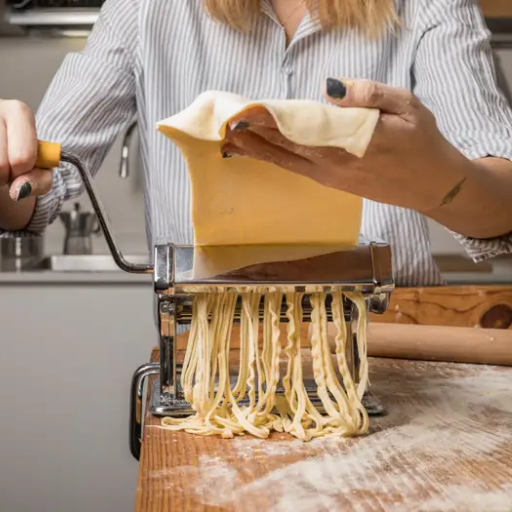Your culinary experience will be enhanced if you make fresh pasta at home, bringing Italy to your kitchen. This article will look at some of the best fresh pasta machines in 2024 and review their features, user-friendliness, and general performance. Whether you’re a beginner who wants to try making pasta or an experienced cook looking for upgraded equipment, this manual will give you helpful information to choose the most suitable pasta maker. Besides, we’ll show you how to prepare homemade pasta that tastes lovely and amazes your loved ones. Are you ready? Let’s jump into the world of fresh pasta makers and find out which one is perfect for your baking experiences!
What is the Best Pasta Maker for Fresh Pasta?
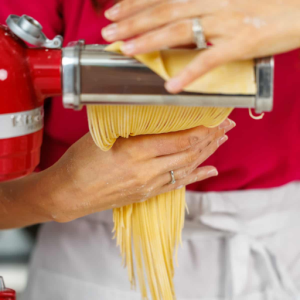
Image source: https://natashaskitchen.com/
Among the best choices of a pasta maker intended for fresh pasta is Marcato Atlas 150. The company is well-known for its robust construction and easy-to-use design; it has diverse thickness settings, so one can personalize their cooking according to preferences. Using stainless steel rollers achieves an equal thickness of the dough, and accessories are included to widen your scope in making pasta with offerings such as fettuccine and lasagna. It is believed by many that Marcato Atlas 150 brings together qualities like quality, diversity, and simplicity, thereby making it accessible to both novice and experienced pasta makers.
Top Pasta Machines for Homemade Pasta in 2024
- Marcato’s Atlas 150: As mentioned earlier, this product is highly valued for its toughness and versatility. The option of adjusting the thickness ensures that perfect pasta sheets can be made according to your taste. Made of stainless steel, the product guarantees durability; in addition, it also has add-ons for different kinds of pasta.
- KitchenAid Pasta Attachment Set: This attachment is ideal for those who already own a KitchenAid stand mixer. The pasta roller and cutters produce uniform thicknesses and shapes, making tagliatelle or spaghetti very easily. It provides convenience and great results to busy home cooks.
- Cuisinart Electric Pasta Maker: This electric device simplifies the process for those who want modern conveniences when it comes to making pasta. It automates the mixing, kneading, and rolling of dough, thus greatly reducing preparation time. While allowing various settings for pasta thicknesses and shapes, Cuisinart satisfies all levels of expertise with its handy feature that makes it possible to have fresh pasta every time.
These options cater to everyone’s tastes in 2024 since they offer a wide range of preferences and budgets, ensuring anyone can access homemade artesian pasta.
Manual vs. Electric Pasta Makers: Which One is Better?
This analysis of whether to buy a hand-operated or electric pasta machine comes down to personal preference and cooking habits. Manual pasta makers, such as the Marcato Atlas 150, provide a hands-on experience that many cooking enthusiasts love. They allow you to have better control over how thick your pasta turns out and can be cheaper than their counterparts, which use electricity. However, they are time-consuming since one requires more effort; hence, they are not recommended for busy people.
On the other hand, electric pasta makers like the Cuisinart Electric Pasta Maker make things easy and fast. These machines automate kneading and rolling, which can be a massive advantage for those who want to produce fresh pasta quickly and with minimal manual effort. They typically come with multiple settings for different types of pasta desired by various skill levels as well as individual preferences.
In conclusion, choosing between manual or electric pasta machines depends on your type of cookery, the amount of time you would like to spend on it, and the particular features you appreciate in making your pasta. If you prefer traditional methods and have enough time, a mechanical maker could be better for you. Otherwise, if efficiency and convenience matter most to you, then an electrical model might just do it.
Why Choose a Philips Pasta Maker?
There are several reasons why Philips Pasta Maker is good. First, it comes with automated mixing, kneading, and shaping options, significantly reducing the time and effort needed to make fresh pasta home. It is such a fantastic thing that endears users to this machine when they find out that it can be used in making diverse pasta shapes like spaghetti, fettuccine, and lasagna using various flour types, thus enhancing its versatility. Besides, its patented design ensures uniform results, which can be attributed to its careful manipulation of the mixing phase and dough extraction. Compactness for easy storage while removable parts simplify cleaning. The Philips Pasta Maker is a convenient, high-quality product with extensive, user-friendly features for beginners and experts who want to produce fresh pasta without much strain.
How Does a Pasta Machine Work?
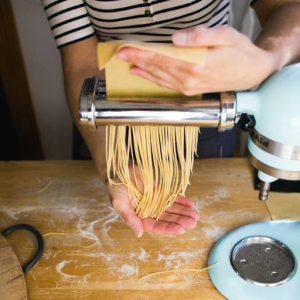
Depending on the model, a pasta-making appliance will roll and cut dough into thin sheets or specific patterns. The first step in using a pasta maker is to prepare the dough by combining flour with water or sometimes eggs until it reaches the desired consistency. At this point, the prepared dough is passed through rollers that flatten it to a certain thickness. Many models have settings that can be adjusted to regulate how thick it should be for different types of pasta when it’s rolled out. Other available attachments or settings can be used to cut this dough into various other shapes like tagliatelle and ravioli. It is easy and efficient, meaning that one can create fresh noodles within minutes without much hassle, thus making sure that individuals have tasty homemade pasta in just a few minutes.
The Mechanics Behind Fresh Pasta Making
Fresh pasta making involves several pieces of equipment, each highly significant in achieving excellent texture and taste. The very first stage entails mixing flour (usually “00” because of its extraordinary fineness) with water and eggs to get a flexible surface. As gluten develops while kneading the dough, elasticity comes from forming gluten strands.
The next step is putting the rolled-out dough into a machine to cut it into thin sheets. Here, one must exercise precise control over thickness; thinner sheets yield a more tender final product. Some of these devices come with adjustable rollers, allowing users to customize thickness according to the type of pasta they will produce.
Finally, while handcrafting some intricate patterns could be an option, most commonly, these machines provide integrated cutters, which make cutting apart so much easier for us all as we try to save time on this demanding process. For consistent pressure across the sheet as well as maintaining its structure, equal force application has been achieved by combining uniform pressure through design elements such as die-shaped screw thread on extrusion barrel 21 and die 20 and seven molded bolts 23 having springs set between nuts 24 thereby forcing them together so that they create enough tension to give consistent pressure while food is being extruded. Finally, one can cook freshly cut pasta or dry it for use in the future, thus keeping the essence of the sauce made from natural herbs, which is characteristic of fresh pasta, separate from its commercial counterpart.
Electric vs. Manual Pasta Machines: Different Operation Styles
Factors mainly about convenience and user experience determine the choice between electric, pasta machines, and manual ones.
Electric Pasta Machines: These machines are built for efficiency and can have powered rollers and cutters that automate the kneading and rolling of dough. This saves time allocated to preparation and energy used during the process, hence making them best suited for those who prepare pasta regularly or in large quantities. Also, less physical exertion is required by electric devices, with many people opting for a more hands-off approach.
Manual Pasta Machines: Conversely, the manual variety necessitates the user’s physical input when it comes to kneading and cutting up dough. These widgets generally come equipped with a handle allowing users to determine how thick they want their paste. Moreover, manual models may be cheaper than their electrical counterparts and require less maintenance, thus attracting amateur chefs or people who are just starting out in pasta production. Nevertheless, they call for more time and effort due to the user’s involvement.
Ultimately, personal preferences regarding convenience, budget constraints, and desired level of involvement in making spaghetti, among other factors, will help select between electric or manually operated pasta machines.
Using Pasta Attachments for Versatile Results
Both electric and manual pasta makers can be fitted with extra plates, expanding their functionality to make other types of pasta for a variety of dishes. For instance, ravioli or lasagna sheets can be made in this case. Using the fettuccine attachment, on the other hand, you will get different attachments designed for specific pasta shapes, like spaghetti.
It also includes extruded pasta such as penne and macaroni. The kitchen has more options, and meal preparation is becoming faster. Restaurant-style meals could easily be prepared at home using the right add-ons that would give an authentic taste to your homemade pasta. This is what will make your cooking different from others; adding these attachments depending on the kind of food being cooked and personal preference will simply increase your enjoyment when preparing any pasta dish.
What are the Features to Look for in a Pasta Maker?
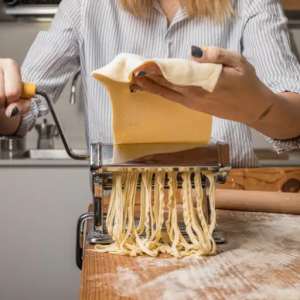
Several essential features can enhance your cooking experience when choosing a pasta maker. The first is the type of pasta maker you should consider—manual or electric; it should be such as to suit your convenience and practicality taste. The next one is the build quality and crucial materials, so it has to be stainless steel for durability and easy cleaning. Such factors as adjustable thickness settings add more flexibility when creating different kinds of pasta, ranging from thick lasagna sheets to delicate angel hair.
Additionally, having attachments for making various pasta shapes would greatly expand culinary possibilities at home. Manual machines with detachable hand cranks make their operation easier and storage more convenient, while electric ones depend on motor power, which affects their efficiency and speed. Finally, if space is limited on your kitchen top, make sure that the size and storage capabilities of the pasta maker also match your requirements. Considering these characteristics, you can find a model that matches your cooking style and personal preferences.
Essential Features of the Best Pasta Makers
Several essential features consistently stand out across leading websites when searching for the top pasta makers. Many users prefer simple operation of their pasta makers, whether manual or electric. Longevity and maintenance are other important factors that influence durability, as reflected by high-quality materials such as stainless steel. With various supplementary tools, users can make different designs and kinds of pasta.
Another significant aspect is that the thickness settings allow customization of various pastas. Similarly, safety measures are implemented to avoid accidents, most notably in electrical appliances. Last but not least, one must always consider its portability, even if it’s just meant for storage purposes, so that fresh pasta lovers with limited kitchen space won’t miss out on anything. By looking at these aspects, you will understand which pasta maker is perfect for both style and ease of cooking in the kitchen.
Exploring Pasta Roller Attachments and Their Benefits
Having a pasta roller attachment can improve your pasta maker by allowing you to make different pasta shapes. The best ones have interchangeable rollers that allow you to prepare sheets of lasagna, fettuccine, or tagliatelle at your convenience. Regulating the thickness of the pasta sheets is advantageous as it allows for personal customization or specific recipe needs.
Many of these e-commerce platforms today stress the convenience aspect of their attachments through which they claim to simplify pasta-making while delivering high-quality results. Besides, users laud attachments for easy cleaning and storage, particularly when they fit well into the main machine. By integrating roller attachments into your pasta supplies, you would add more flavor variation to your kitchen and improve efficiencies and funs.
The Pros and Cons of Selecting a Marcato Atlas 150 Pasta Machine
The Marcato Atlas 150 pasta machine is favored by most home cooks with its pluses and minuses as highlighted.
Pros:
- Quality Standards and Longevity: Built in Italy, the Marcato Atlas 150 is known for its robust construction and durable materials that enable it to withstand frequent use.
- Versatility: This machine has multiple settings for the thickness, so it can make numerous types of pasta, from thin sheets used in lasagna to thicker ones found in fettuccine.
- Ease of Use: This appliance’s simplicity in design makes it popular among users who appreciate simple things—even starters can produce fresh pasta without complicated procedures.
Cons:
- Manual Operation: However, some individuals may find a drawback in using this manual device instead of an automatic one they prefer as self-operating.
- Size and Weight: Although portable, the Marcato Atlas 150 occupies more space on the kitchen counter than some other compact models, an issue that might matter to people with smaller kitchens.
- Price Point: Regarding price ranges, it usually meets higher standards than other brands, thus making it less affordable than others when people have limited budgets.
After weighing these pros and cons, one can decide whether or not getting a Marcato Atlas 150 is right for their kitchen.
How Easy is it to Make Fresh Pasta at Home?
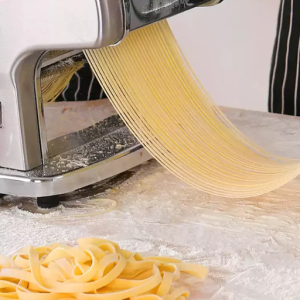
Surprisingly, making fresh pasta from scratch in your kitchen is a breeze, even for novices. It requires only some elemental components, including flour, eggs, and a pinch of salt as the main ingredients. First, you can make a well in the flour, pour in eggs, then mix until doughy. Next, knead the dough for about ten minutes till it becomes smooth and elastic. After at least 30 minutes resting time, roll out the dough with a pasta machine, e.g., Marcato Atlas 150, or if not available, use a rolling pin until you get your desired thinness. Cut the pasta into your preferred shapes and boil them for a few minutes. This is an easy and fun cooking activity that one can quickly perfect, given some experience and time spent.
Step-by-Step Guide to Using a Pasta Machine
- Prepare the Dough: Mix flour, eggs, and some salt to form a dough. Knead it until smooth, then let it rest for at least 30 minutes.
- Set Up the Pasta Machine: Set the pasta machine’s settings to the widest position. These settings are very important for rolling the dough into thin sheets.
- Divide the Dough: Cut the rested dough into smaller lots, making it easy to handle while rolling.
- Rolling out the Dough: Take one part and press it down gently using your hands. Then, go ahead and feed this through a pasta machine. Fold over the dough once more and repeat this by running it through again to make a smoother texture.
- Gradually Reduce Thickness: Adjust the machine to the next setting and run the pasta through again after every adjustment. Continue with this process as you move to thinner settings until the desired thickness is achieved.
- Cutting Pasta: Once you have rolled out some dough, use your machine’s cutting attachment or a knife to cut it into whatever shape you prefer, such as fettuccine or lasagna sheets.
- Sprinkle/ dust with flour: Sprinkle just a little flour on top of that sliced pasta so it can not stick together.
- Cook Pasta: Boil salted water until boiling, then cook for 2-4 minutes, depending on its thickness; serve with your favorite sauce.
In conclusion, making fresh pasta at home using a machine can be fulfilling and fun if these steps are followed correctly.
Tips for Perfect Pasta Dough Preparation
- Use the Proper Flour: Good texture can be produced by using “00” flour, characterized by its high content of proteins and delicate texture that makes it easy to achieve perfect al dente pasta. If not available, all-purpose flour could also do.
- Precise Measurement of Ingredients: Don’t rush while measuring your flour and eggs. Usually, a rough ratio per egg is about 100 grams of flour. This helps you ensure consistency in your dough.
- Thorough Kneading: Smooth and elastic are two words used to describe thoroughly kneaded dough; take at least 10-15 minutes for this step. It enhances gluten development, responsible for chewy and tough pasta textures.
- Allow the Dough to Rest: You should give your dough a minimum resting time of about half an hour, covered with cling film; this period hydrates the flour, resulting in a soft dough that is easier to roll out.
- Controlled Environment Works Best: Make sure you work amidst fair humidity levels and cool temperatures in your kitchen area. Use more dusting flour if necessary but with caution to avoid over-flour, which may leave it dry or crumbly, incredibly, when sticky.
By following these tips, you can improve on making homemade pasta and enjoy mouthwatering meals at home.
Pasta Recipes to Try with Your New Pasta Maker
- Classic Fettuccine Alfredo: Mix fresh fettuccine with butter, heavy cream, and Parmesan cheese. Cook the pasta in boiling water for a few minutes, then drain and toss in the sauce.
- Ravioli with Spinach and Ricotta: Spread pasta dough into thin layers and add spinach, ricotta, and Parmesan. Sprinkle lemon zest over the ravioli before pouring olive oil on top.
-
Pappardelle with Bolognese Sauce: Using your pasta machine, cut thick strips of pappardelle for serving with sauces that have lots of meat. Bring ground meat, tomatoes, aniseeds, or cloves to a simmering point; these are the ingredients for traditional Bolognese sauce, which goes well with pappardelle immediately after cooking it.
Which Pasta Maker Brands are the Most Reliable?
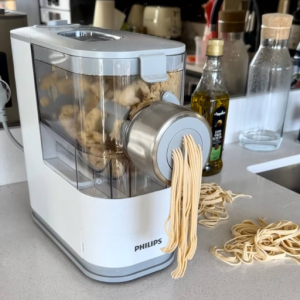
Certain brands attract attention when selecting a pasta maker due to their quality and durability. One of the most well-built pasta makers available is Marcato, which often impresses with its robust construction and excellent performance by both home cooks and professionals alike. KitchenAid comes with a wide range of add-on accessories for their stand mixers, making creating reliable, healthy pasta dishes easier. Cuisinart also designs products that are very easy to use yet solidly built. Last, there is also Imperial, which is more traditional in manufacturing finely crafted hand-operated machines. Therefore, when choosing your pasta maker, think about what you like eating most often, how much money you can afford to spend on it, and the type of noodles you envisage making.
Comparing Imperia, KitchenAid, and Philips Pasta Makers
When selecting the top brands of pasta makers, certain features distinguish Imperia, KitchenAid, and Philips.
Imperia is known for its old-fashioned design and workmanship, which makes it suitable for those who value handmade pasta. It has to be operated manually most of the time, allowing users to personally manage the thickness and shape of their noodles to achieve an authentic taste.
Meanwhile, KitchenAid employs stand mixer versatility, hence its popularity. It can integrate with your stand mixer thanks to its pasta attachment, thereby creating space for numerous kinds of pasta without having to add more counter space in your kitchen. This means that those who are after practicality at the expense of quality will find this helpful.
What sets Philips apart from others is automation. They come with preset recipes and operate with a single touch, making them perfect for people who want an automatic way of making pasta. The machines from Philips can mix ingredients quickly and extrude fresh pasta, making them ideal for busy cooks and efficiency-minded individuals.
In a nutshell, Imperia is preferred by those who love tradition, while KitchenAid offers convenience and flexibility, and Philips is recommended for people looking for speedy solutions. Preferences based on authenticity, ease of use, and preparation speed determine the best choice when purchasing a pasta maker.
Why the Marcato Atlas 150 is a Favorite Among Pasta Enthusiasts
Widely celebrated among pasta connoisseurs, the Marcato Atlas 150 is highly regarded for its outstanding quality and flexibility. Made in Italy, this hand-operated pasta machine embodies old-fashioned workmanship but also incorporates elements of modern design. Robustness in stainless steel construction ensures that users can create a kind of pasta that competes with authentic Italian kitchens. Nine adjustable thickness settings allow for complete control over dough preparation, with the Atlas 150 allowing pasta lovers to get various textures and thicknesses for different types of pasta, such as lasagna or tagliatelle. Additionally, it has user friendliness and simple manual operation, making it suitable for experienced chefs and novices alike, thus establishing it as a popular pick for home-based craftspersonship in pasta making. Tradition, durability, and easy-to-use design have made the Marcato Atlas 150 so much loved by all those who adore noodles globally.
Do I Need Additional Accessories for My Pasta Maker?
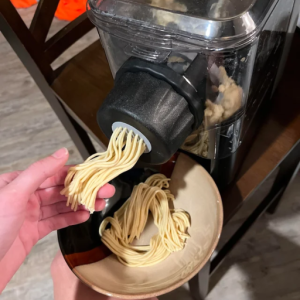
Although most pasta makers are equipped with essential components for making various types of pasta, there are additional accessories that you can buy to create a better experience of making pasta. Some tools, such as the cutters for spaghetti and fettuccine, will effortlessly help you diversify the shapes of your pasta. A drying rack is also advantageous when maintaining fresh noodles’ quality by preventing them from sticking together. Finally, purchasing a dough scraper or board can assist in simplifying the process by which dough is prepared and managed. However, none of these accessories are obligatory; some home cooks happily prepare delicious pasta with only their primary makers.
The Importance of Pasta Roller Attachments
Pasta roller attachments are essential in improving how versatile and efficient your pasta-making experience is at home and in a restaurant. Designed often for specific kinds of paste, these attachments remove all the uncertainties about achieving even thickness or shapes that can significantly increase the quality of a meal. For example, they may be used to make lasagna sheets, ravioli, or fettuccini, thus giving homemade pastes almost identical texture to those manufactured traditionally. Moreover, it saves time and strength if you use these rollers because the dough can be rolled faster than with a manual roller. When placing attachments into your everyday pasta-making routine, one can quickly cook more varied dishes; hence, they become must-haves for any would-be enthusiast who wants to test his hand at Italian cuisine.
Benefits of a Pasta Drying Rack
Home cooks can have a pasta drying rack and get several benefits from having it. One of them is that with its help, the noodles will get air evenly distributed to stop them from sticking together and acquire uniformity while drying. The overall consistency must be maintained to achieve an ideal texture that would make cooking al dente pasta easier. The other thing is that these racks reduce the possibility of pasta sticking together; hence, uneven cooking results may arise. Finally, an organizer coat stand helps streamline the process of making pasta by removing mess from counters, allowing larger quantities to be prepared at once. There are many advantages to purchasing a past drying rack; besides improving quality, it fast tracks production, thus becoming a useful tool for all pasta lovers.
Must-Have Accessories for Making Pasta Like a Pro
To elevate your pasta-making experience, consider these essential accessories that professionals swear by:
- Pasta Machine: An adjustable pasta machine rolls dough of your desired thickness, ensuring uniformity in every result. Search for models with various attachments to make different pasta shapes.
- Chitarra Cutter: This traditional tool makes cutting fresh pasta easier and more precise, especially for dishes like spaghetti or fettuccine. The wire strings on the chitarra cut through the dough, leaving uniform patterns.
- Pasta Measuring Tools: To get perfect servings, one must be accurate while portioning. Purchase tools such as pasta forks or portion scoops to help you manage servings better and ensure that no one is left wanting more or has too much left.
Utilizing these accessories will streamline your process and elevate your homemade pasta to restaurant-quality dishes.
Frequently Asked Questions (FAQs)
Q: What should I look for in a pasta maker machine?
A: Key factors to consider when choosing a pasta maker machine include its build quality, ease of use, the types of pasta shapes it can produce, and whether it is a manual machine or an electric pasta machine. Also, pay attention to additional features like a pasta cutter and attachments that may come with the machine.
Q: Are manual pasta makers better than electric machines?
A: It depends on your preferences and needs. A manual pasta maker gives you more control over the thickness and consistency of the pasta but requires more effort and time. On the other hand, an electric pasta machine is quicker and requires less manual effort, making it ideal for those who frequently make large quantities of pasta.
Q: What are the advantages of a pasta maker attachment for KitchenAid?
A: A KitchenAid pasta maker attachment offers versatility and convenience, transforming your mixer into a pasta-making machine. The KitchenAid pasta roller attachment and similar tools allow you to roll out sheets of pasta and cut them into different shapes efficiently.
Q: How do I use an Imperia pasta machine?
A: The Imperia pasta machine is a famous manual pasta maker. Start by clamping the machine to your countertop. Then, feed your fresh pasta dough through the rollers to create a pasta sheet. Gradually reduce the thickness setting until you achieve the desired thickness. Use the pasta cutter attachment to make your chosen pasta shapes.
Q: Is the Philips 7000 Series Pasta and Noodle Maker suitable for beginners?
A: Yes, the Philips 7000 Series Pasta and Noodle Maker is highly recommended for beginners due to its ease of use and automated features. It simplifies the process of making fresh pasta with minimal effort.
Q: What are the best electric pasta makers on the market?
A: The best electric pasta makers often mentioned include the Philips 7000 Series and various models by Imperia and KitchenAid. These machines provide quick and efficient ways to produce different pasta shapes with ease of use in mind.
Q: How do I clean my pasta maker machine?
A: Cleaning your pasta maker machine varies depending on whether you have a manual or electric model. Generally, you should avoid using water. Instead, use a brush or cloth to remove any dough remnants. Some parts might be dishwasher safe, especially with electric models, but always follow the manufacturer’s instructions.
Q: Can I use a pasta maker to make filled pasta?
A: Many pasta makers can help you create filled pasta varieties, such as ravioli. You’ll usually need to roll out sheets of pasta dough first with your pasta maker machine, then use specific attachments or tools to fill and seal the pasta.
Q: What types of pasta can I make with a pasta roller and cutter set?
A: A pasta roller and cutter set allows you to make various pasta shapes. Standard options include spaghetti, fettuccine, and lasagna sheets. With additional attachments, you can also create more intricate shapes and styles of pasta.
Q: How does the KitchenAid Pasta Roller differ from the Pasta Roller and Cutter set?
A: The KitchenAid Pasta Roller is primarily used to roll out sheets of pasta dough, which can be cut by hand or with separate attachments. The Pasta Roller and Cutter set includes roller and cutting attachments, enabling you to roll and cut various pasta shapes more efficiently in one go.












